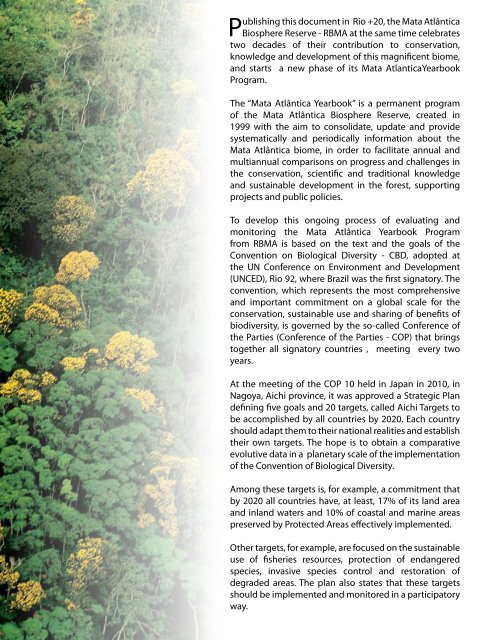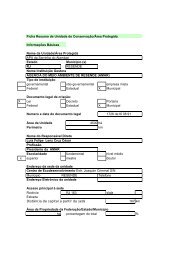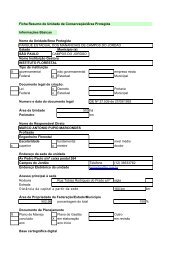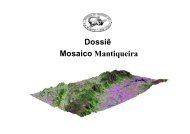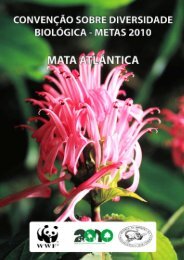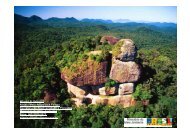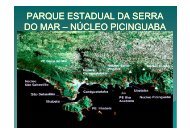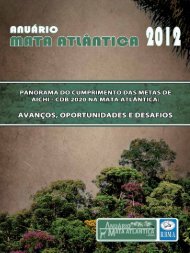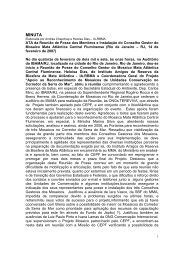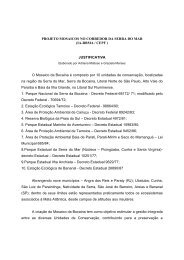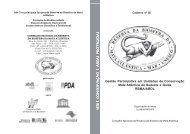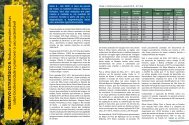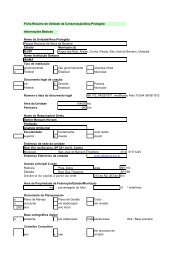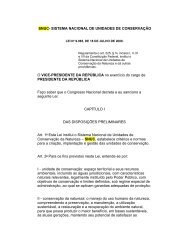target 1 - Reserva da Biosfera da Mata Atlântica
target 1 - Reserva da Biosfera da Mata Atlântica
target 1 - Reserva da Biosfera da Mata Atlântica
Create successful ePaper yourself
Turn your PDF publications into a flip-book with our unique Google optimized e-Paper software.
Publishing this document in Rio +20, the <strong>Mata</strong> <strong>Atlântica</strong><br />
Biosphere Reserve - RBMA at the same time celebrates<br />
two decades of their contribution to conservation,<br />
knowledge and development of this magnificent biome,<br />
and starts a new phase of its <strong>Mata</strong> AtlanticaYearbook<br />
Program.<br />
The “<strong>Mata</strong> <strong>Atlântica</strong> Yearbook” is a permanent program<br />
of the <strong>Mata</strong> <strong>Atlântica</strong> Biosphere Reserve, created in<br />
1999 with the aim to consoli<strong>da</strong>te, up<strong>da</strong>te and provide<br />
systematically and periodically information about the<br />
<strong>Mata</strong> <strong>Atlântica</strong> biome, in order to facilitate annual and<br />
multiannual comparisons on progress and challenges in<br />
the conservation, scientific and traditional knowledge<br />
and sustainable development in the forest, supporting<br />
projects and public policies.<br />
To develop this ongoing process of evaluating and<br />
monitoring the <strong>Mata</strong> <strong>Atlântica</strong> Yearbook Program<br />
from RBMA is based on the text and the goals of the<br />
Convention on Biological Diversity - CBD, adopted at<br />
the UN Conference on Environment and Development<br />
(UNCED), Rio 92, where Brazil was the first signatory. The<br />
convention, which represents the most comprehensive<br />
and important commitment on a global scale for the<br />
conservation, sustainable use and sharing of benefits of<br />
biodiversity, is governed by the so-called Conference of<br />
the Parties (Conference of the Parties - COP) that brings<br />
together all signatory countries , meeting every two<br />
years.<br />
At the meeting of the COP 10 held in Japan in 2010, in<br />
Nagoya, Aichi province, it was approved a Strategic Plan<br />
defining five goals and 20 <strong>target</strong>s, called Aichi Targets to<br />
be accomplished by all countries by 2020. Each country<br />
should a<strong>da</strong>pt them to their national realities and establish<br />
their own <strong>target</strong>s. The hope is to obtain a comparative<br />
evolutive <strong>da</strong>ta in a planetary scale of the implementation<br />
of the Convention of Biological Diversity.<br />
Among these <strong>target</strong>s is, for example, a commitment that<br />
by 2020 all countries have, at least, 17% of its land area<br />
and inland waters and 10% of coastal and marine areas<br />
preserved by Protected Areas effectively implemented.<br />
Other <strong>target</strong>s, for example, are focused on the sustainable<br />
use of fisheries resources, protection of en<strong>da</strong>ngered<br />
species, invasive species control and restoration of<br />
degraded areas. The plan also states that these <strong>target</strong>s<br />
should be implemented and monitored in a participatory<br />
way.<br />
Yearbook <strong>Mata</strong> <strong>Atlântica</strong> 2012 - 3


